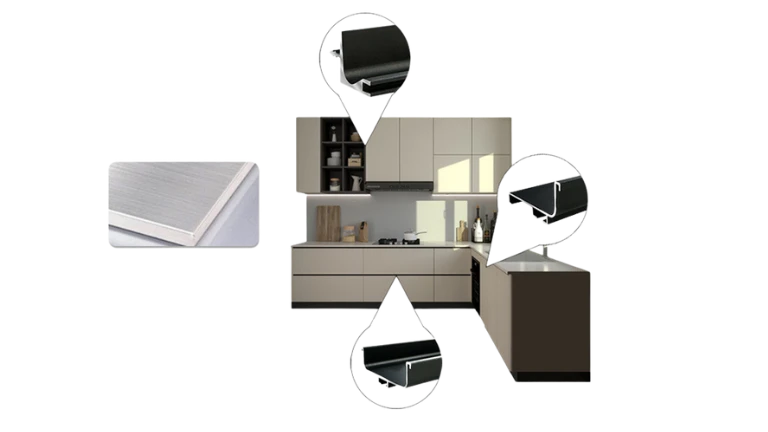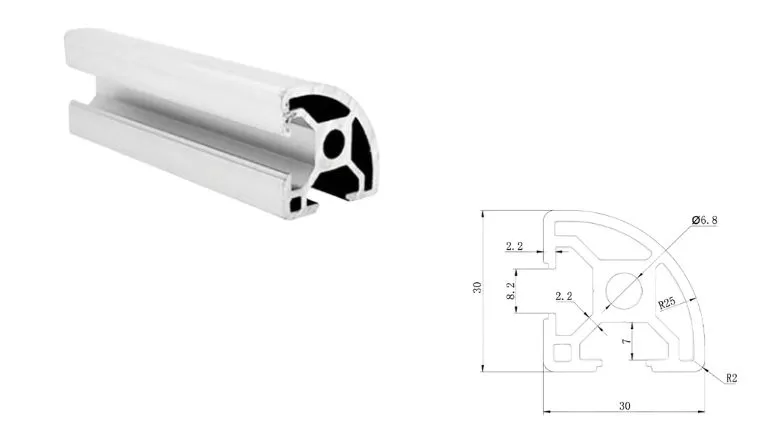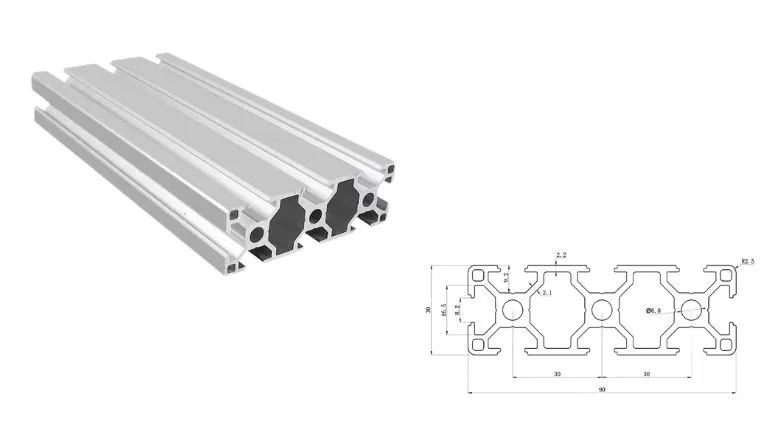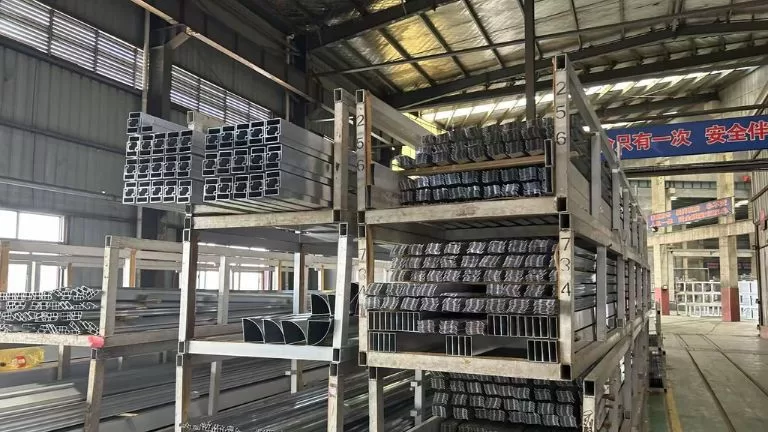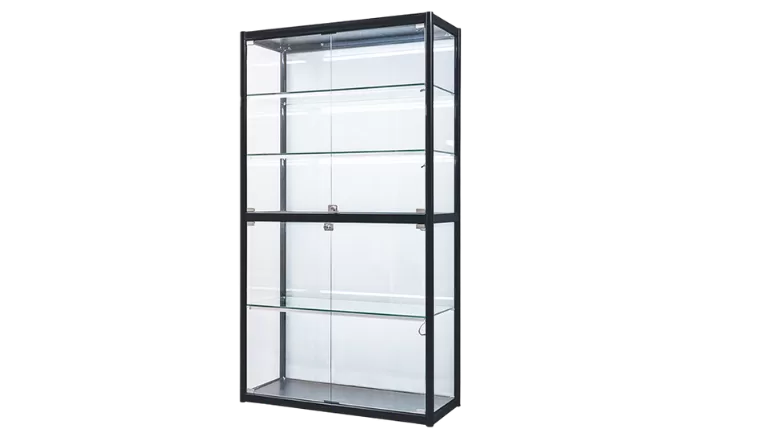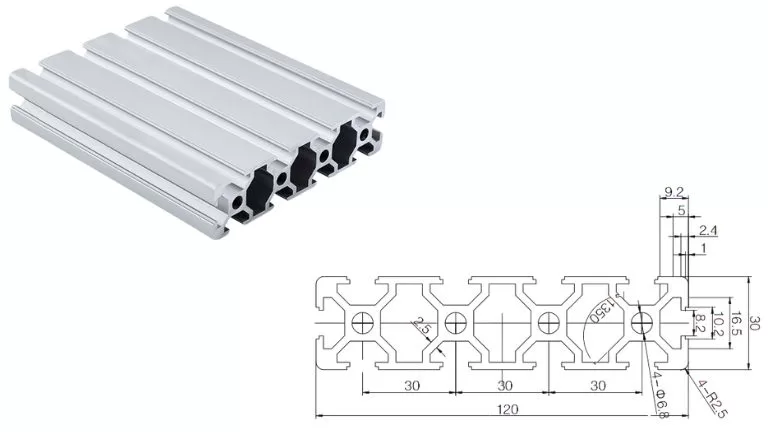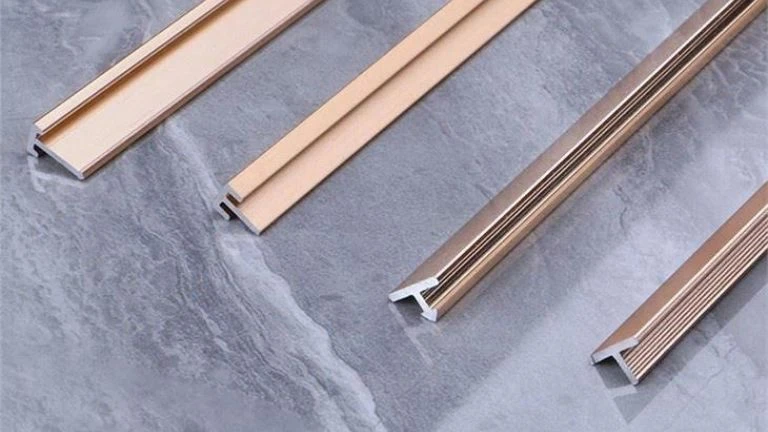Custom Aluminum 6005 T5 | T6 Extrusions

6005 aluminum alloy, part of the 6xxx series, consists of magnesium (Mg) and silicon (Si), offering excellent formability, corrosion resistance, and weldability. It is ideal for producing complex extruded profiles.
6005 extruded aluminum profiles feature high strength, corrosion resistance, and excellent extrudability. They are widely used in construction, industrial manufacturing, solar mounting systems, and electric vehicle components.
At HTS-ALU, we manufacture high-quality 6005 aluminum profiles with 40 advanced extrusion lines, complete surface treatments, and machining capabilities to meet diverse industry needs.
Composition of 6005 Aluminum Alloy
6005 aluminum alloy is a medium-strength alloy with a carefully balanced composition, offering an excellent combination of strength, corrosion resistance, machinability, and weldability. The synergy of its elements provides unique and superior performance. The following are the effects of the key components in 6005 aluminum alloy:
1. Silicon (Si): Enhances strength and improves extrusion performance, making it suitable for complex and thin-walled profiles.
2. Magnesium (Mg): Significantly increases strength through heat treatment while maintaining excellent corrosion resistance.
3. Iron (Fe): Improves hardness but must be controlled to avoid reducing ductility and causing brittleness.
4. Copper (Cu): Refines the grain structure and slightly improves toughness, while low amounts ensure corrosion resistance.
5. Manganese (Mn): Contributes to grain refinement and enhances impact resistance and durability.
6. Chromium (Cr): Stabilizes the alloy structure, improving toughness and corrosion resistance.
7. Zinc (Zn): Adds minor strength in small amounts but is kept minimal to preserve corrosion resistance.
8. Titanium (Ti): Acts as a grain refiner, improving mechanical properties and processing performance.
9. Aluminum (Al): The primary base metal, providing lightweight properties, exceptional corrosion resistance, and good thermal and electrical conductivity.
| Element | Range (%) |
|---|---|
| Silicon (Si) | 0.6-0.9 |
| Iron (Fe) | ≤0.35 |
| Copper (Cu) | ≤0.10 |
| Manganese (Mn) | ≤0.10 |
| Magnesium (Mg) | 0.4-0.6 |
| Chromium (Cr) | ≤0.10 |
| Zinc (Zn) | ≤0.10 |
| Titanium (Ti) | ≤0.10 |
| Aluminum (Al) | Balance |
Features of 6005 Aluminum Profiles
1. Excellent Extrusion Performance
- 6005 aluminum alloy offers outstanding extrusion performance, allowing the production of long, thin-walled, or complex profiles such as T, L, U, rectangular, and channel shapes.
2. High Strength and Rigidity
- Compared to other aluminum alloys, 6005 provides higher strength, making it ideal for load-bearing and high-flex resistance structures.
3. Superior Corrosion Resistance
- With excellent oxidation properties, 6005 aluminum profiles resist corrosion effectively, especially in outdoor, humid, or high-salt environments. They are widely used in construction and photovoltaic systems.
4. Good Weldability
- Can be reliably connected using appropriate welding techniques such as TIG or MIG welding, particularly suitable for assembled frame structures.
5. Versatile Surface Treatments
- Anodizing: Enhances corrosion resistance and forms a uniform oxide layer, suitable for architectural finishes.
- Powder Coating: Allows a wider range of color options.
- Polishing/Brushing: Improves surface finish for high-end products.
Physical and Mechanical Properties
| Parameter | Value |
|---|---|
| Tensile Strength (σb) | 230-280 MPa |
| Yield Strength (σp0.2) | ≥200 MPa |
| Brinell Hardness (HB) | 70-90 |
| Elongation | ≥12% (Transverse) |
| Density | ~2.70 g/cm³ |
| Thermal Conductivity | ~180-190 W/m·K |
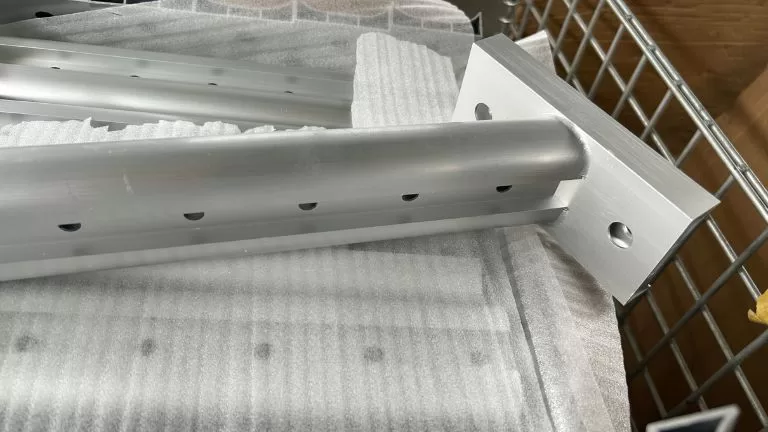
6005-T5 Aluminum Profiles
Definition:
- T5 means the 6005 alloy is air-cooled (natural or forced) from the extrusion temperature and then artificially aged for balanced strength and hardness.
Properties:
- Strength: Moderate tensile and yield strength, suitable for structural uses.
- Ductility: Better ductility compared to T6, allowing post-extrusion bending or modifications.
- Corrosion Resistance: Excellent corrosion resistance for outdoor environments.
Applications:
- Found in architectural structures, automotive parts, and general profilesneeding good strength and flexibility.
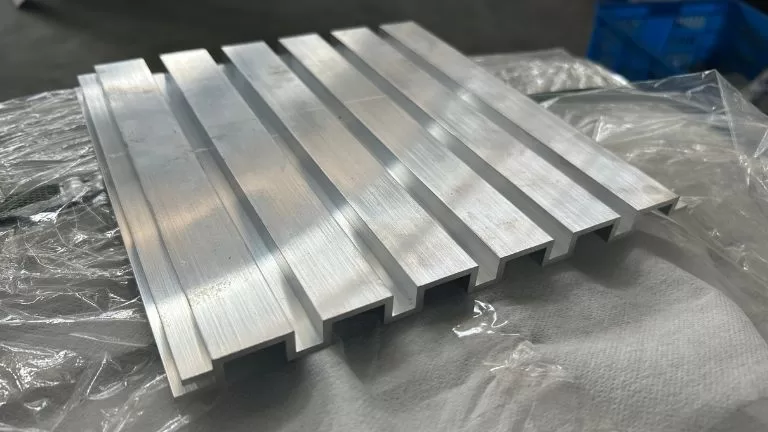
6005-T6 Aluminum Profiles
Definition:
- T6 means the 6005 alloy is water-cooled after extrusion, followed by artificial aging to reach maximum strength and hardness.
Properties:
- Strength: Higher tensile and yield strength compared to T5, suitable for heavy-load uses.
- Ductility: Reduced ductility, making it less suitable for reshaping after extrusion.
- Corrosion Resistance: Excellent corrosion resistance, like T5.
Applications:
- Commonly used in high-strength structural components, industrial equipment, solar panel frames, and transportation systems.
| Aspect | 6005-T5 Aluminum Profiles | 6005-T6 Aluminum Profiles |
|---|---|---|
| Cooling Method | Air cooling (natural or forced) | Water quenching (faster cooling) |
| Strength | Moderate tensile and yield strength | Higher tensile and yield strength |
| Ductility | Better ductility, easier to bend or modify | Lower ductility, less suitable for reshaping |
| Hardness | Balanced hardness for general applications | Greater hardness for heavy-duty uses |
| Corrosion Resistance | Excellent | Excellent |
| Applications | Architectural structures, automotive components, lightweight/moderate strength uses | High-strength structures, industrial equipment, solar panels, transportation systems |
Comparison: 6005-T5 vs. 6005-T6 Aluminum Profiles
Aluminum Profile Processing Capabilities
As a leading aluminum extrusion manufacturer based in China, we are committed to providing high-quality aluminum profiles for a wide range of industries. Our capabilities start with custom mold design and manufacturing, ensuring precise extrusion shapes that meet the specific needs of our clients. From raw extrusion to surface finishing and advanced machining, our fully integrated manufacturing processes enable us to deliver aluminum profiles that meet exacting standards and cater to the unique requirements of each project.
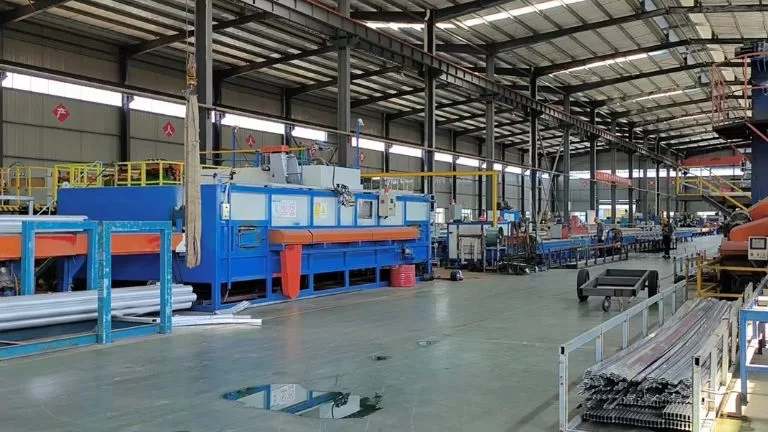 Our production facility houses over 40 advanced extrusion lines, featuring cutting-edge equipment such as a powerful 6000-ton extrusion press. This enables the creation of aluminum profiles in various sizes and forms, ranging from standard industrial applications to specialized products like thermal break profiles for high-end doors and windows. The flexibility of our extrusion capability ensures we can cater to a broad spectrum of industries, including construction and precision engineering.
Our production facility houses over 40 advanced extrusion lines, featuring cutting-edge equipment such as a powerful 6000-ton extrusion press. This enables the creation of aluminum profiles in various sizes and forms, ranging from standard industrial applications to specialized products like thermal break profiles for high-end doors and windows. The flexibility of our extrusion capability ensures we can cater to a broad spectrum of industries, including construction and precision engineering.
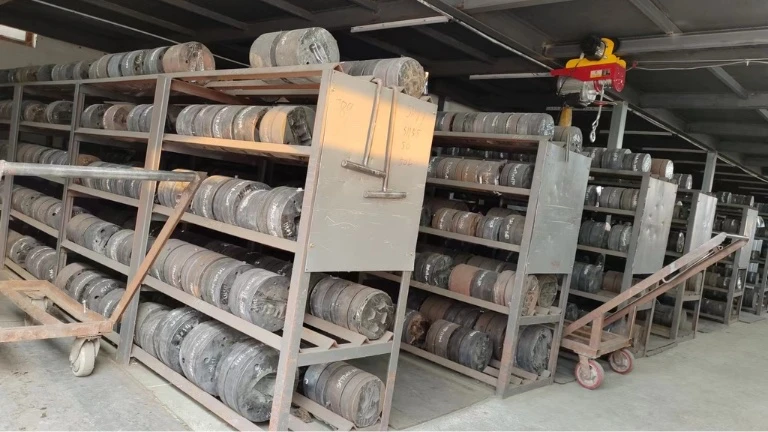 We possess the expertise to design and produce extrusion molds in-house, ensuring precision and efficiency in aluminum profile manufacturing. Our experienced team works closely with clients to develop custom molds based on drawings or samples, ensuring optimal performance for their specific requirements. Typically, the mold production process takes about 7 days, after which we provide samples for client confirmation before beginning full-scale production.
We possess the expertise to design and produce extrusion molds in-house, ensuring precision and efficiency in aluminum profile manufacturing. Our experienced team works closely with clients to develop custom molds based on drawings or samples, ensuring optimal performance for their specific requirements. Typically, the mold production process takes about 7 days, after which we provide samples for client confirmation before beginning full-scale production.
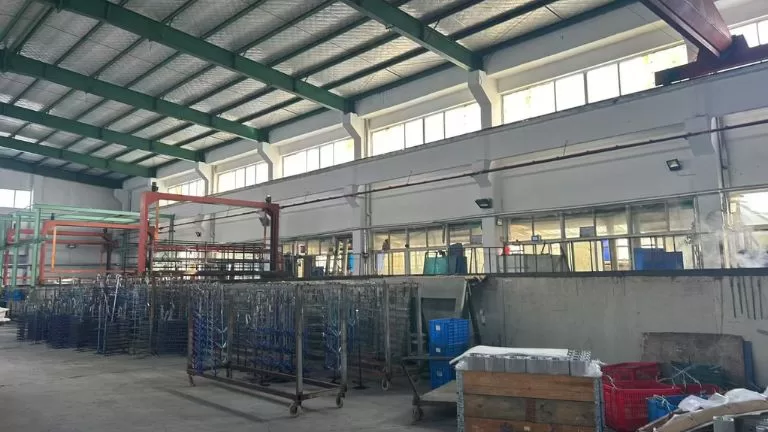
For superior durability and visual appeal, we offer various surface treatment solutions. These include anodizing for added corrosion resistance, powder coating for vibrant finishes, fluorocarbon coating for enhanced weather resistance, and wood grain transfer technology for elegant, natural-looking designs. These treatments are customizable to fit specific aesthetic and functional needs, ensuring that profiles not only perform well but also look exceptional.

To provide complete aluminum profile solutions, we offer extensive further processing capabilities. Our services include CNC machining, milling, threading, drilling, precision cutting, punching, welding, and assembly. This range of fabrication options allows us to deliver ready-to-use profiles tailored to exact project specifications, offering unmatched flexibility and reliability to our customers.
Custom 6005 Aluminum Extrusion from Us
At HTS NEW MATERIALS, we specialize in providing custom aluminum extrusions designed to meet your unique requirements. With advanced production facilities and over 40 extrusion lines, we deliver premium, precision-engineered profiles for a wide range of industries, including aerospace, automotive, construction, and more.
Our custom extrusion services include:
- Tailored Cross-Sections: Create unique aluminum profiles with our expert die-making capabilities, customized to suit your specific project needs.
- Diverse Surface Finishes: Enhance both the appearance and durability of your profiles with options like anodizing, powder coating, polishing, and more.
- Precision Machining: Ensure exact dimensional accuracy with cutting, drilling, milling, and advanced machining services.
- Flexible Tempers: Select from a variety of heat treatments, including T5, T6, and others, to achieve the ideal mechanical properties for your application.
Partner with HTS NEW MATERIALS for innovative, cost-effective, and dependable custom aluminum extrusion solutions that drive the success of your project.
RFQ of Extruded Aluminum Profile
HTS New Materials, based in Jiangxi Province, China, is a leading aluminum extrusion manufacturer with over 40 advanced production lines and powerful equipment, including a 6000-ton extrusion press. We produce a wide range of aluminum profiles for industries such as construction, industrial applications, and high-end doors and windows, including thermal break profiles. Our services extend to comprehensive surface treatments like anodizing, powder coating, fluorocarbon coating, and wood grain transfer, as well as advanced machining and fabrication capabilities such as CNC machining, drilling, and welding. Committed to quality and innovation, we deliver tailored aluminum solutions to meet the diverse needs of clients globally.
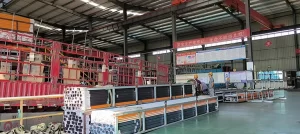


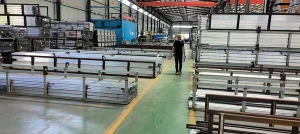



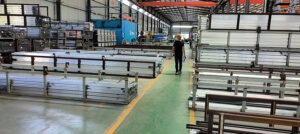
| Aspect | 6005 | 6063 | 6061 | 6082 |
|---|---|---|---|---|
| Primary Use | Structural and moderately high-strength applications | Architectural profiles and decorative applications | Structural and aerospace applications requiring high strength | Heavy-duty structural and machining applications |
| Strength | Moderate tensile and yield strength | Lower strength compared to 6005 and 6061 | High strength, suitable for heavy loads | Very high strength, higher than 6061 |
| Corrosion Resistance | Excellent | Excellent, superior to 6005 and 6061 | Excellent, but slightly lower than 6063 | Excellent, similar to 6061 |
| Ductility | Moderate; suitable for some post-processing | High ductility; easily extruded and bent | Moderate; better than 6082 but lower than 6063 | Lower ductility; less suitable for complex bending |
| Machinability | Good | Fair; less machinable due to softness | Excellent, widely used for machining | Good, similar to 6005 but less than 6061 |
| Weldability | Good, but lower than 6063 and 6061 | Excellent, ideal for welding | Excellent, commonly used in welding applications | Good, but slightly lower than 6061 |
| Extrusion Performance | Very good, suitable for complex profiles | Excellent, ideal for thin-walled profiles | Good, but less extrusion-friendly | Moderate, less extrusion-friendly |
| Typical Applications | Structural profiles, transportation systems, and industrial applications | Architectural frames, decorative applications, light-duty structures | Aerospace parts, automotive components, structural and marine applications | Bridges, cranes, trusses, and other heavy-duty structures |
| Heat Treatment | Can be heat treated to T5 or T6 | Can be heat treated to T5 or T6 | Can be heat treated to T6 or T651 | Primarily used in T6 or T651 |
Aluminum extrusions undergo various surface treatments to enhance aesthetics, corrosion resistance, and functionality. Here are the common surface treatment methods used in the industry:
Main Surface Treatment Methods
Anodizing (Oxidation)
- Process: A controlled electrochemical process that forms a protective oxide layer on the aluminum surface.
- Features:
- Provides a durable, corrosion-resistant, and environmentally friendly finish.
- Produces a metallic finish with a variety of natural tones (e.g., silver, black, bronze).
- Improves surface hardness and protects against scratching.
- Applications: Architectural frames, decorative profiles, heat sinks.
Electrophoresis Coating (E-Coating)
- Process: After anodizing, the aluminum is coated with paint using an electrochemical process.
- Features:
- Enhances corrosion resistance and offers a smooth, glossy finish.
- Provides more color and texture variation compared to anodizing alone.
- Applications: Furniture profiles, indoor architectural components.
Powder Coating
- Process: Electrostatic application of powder paint, followed by curing under high temperature to form a solid coating.
- Features:
- Wide variety of colors and textures.
- Excellent weather resistance and corrosion protection.
- Cost-effective and highly versatile.
- Applications: Outdoor frames, fences, railings, general industrial use.
PVDF Coating (Polyvinylidene Fluoride)
- Process: A specialized fluoropolymer coating is applied in multiple layers, commonly over a pretreated surface.
- Features:
- Exceptional weather resistance and UV stability.
- Highly durable, resistant to fading, chalking, and chemical damage.
- Ideal for long-term outdoor use.
- Applications: Curtain walls, high-performance architectural facades.
Wood Grain Transfer Printing
- Process: A heat-transfer printing process that applies a wood grain effect onto a pre-coated aluminum surface.
- Features:
- Mimics the appearance of wood while retaining aluminum’s durability.
- Lightweight and weather-resistant alternative to natural wood.
- Applications: Furniture, decorative coverings, outdoor panels.
Film Lamination
- Process: Adhesive application of a protective or decorative film onto the aluminum surface.
- Features:
- Provides a glossy, textured, or patterned finish.
- Often used for applications requiring specific textures like marble or leather effects.
- Applications: Interior decor, windows.
Pre-Treatment Processes
Prior to surface treatment, the aluminum surface can be pre-processed for specific textures or finishes:
Brushing/Polishing
- Removes surface imperfections and creates a smooth, reflective finish.
- Often used for decorative purposes.
Sanding/Grinding
- Produces a matte or satin finish by applying abrasives.
Shot Blasting/Sandblasting
- Sprays abrasives at high velocity to create a textured surface, often used before anodizing for a uniform appearance.
Stretching and Tension Leveling
- Straightens the aluminum profile and improves shape accuracy after extrusion.
Cost and Durability Comparison Table
| Treatment Method | Process Cost | Surface Durability | Weather Resistance | Applications |
|---|---|---|---|---|
| Anodizing (Oxidation) | Medium | Very Durable | High | Architectural frames, industrial parts. |
| Electrophoresis (E-Coating) | Medium-High | Durable | Medium | Furniture, indoor parts, decorative uses. |
| Powder Coating | Medium | Highly Durable | High | Outdoor frames, industrial fixtures. |
| PVDF Coating | High | Extremely Durable | Excellent | Curtain walls, high-end exteriors. |
| Wood Grain Printing | Medium | Moderate (topcoat dependent) | Medium | Decorative panels, furniture. |
| Film Lamination | Low-Medium | Moderate | Low | Indoor decorations, windows. |
| Brushing/Sandblasting (Pre-Treatment) | Low | Not Applicable (Preparation only) | N/A | Preparation for further treatment. |
. Anodizing (Oxidation)
- Common Colors:
Natural silver
Black
Champagne
Light bronze
Dark bronze
Gold
2. Electrophoresis Coating (E-Coating)
- Common Colors:
Black
Champagne
Light bronze
Dark bronze
Custom metallic colors
3. Powder Coating
- Colors:
Can match any color based on the RAL color chart.
Offers textures like matte, gloss, satin, and custom finishes.
4. PVDF Coating (Polyvinylidene Fluoride)
- Colors:
Also customizable using the RAL color chart.
High-end finishes with matte or glossy effects.
5. Wood Grain Transfer Printing
- Colors and Patterns:
Mimics various wood types (e.g., oak, walnut, teak, mahogany).
Custom patterns available based on provided samples.
6. Film Lamination
- Colors and Patterns:
Includes textures like marble, leather, and solid colors.
Custom finishes and patterns based on provided samples.
Pre-Treatment Options (Impact on Final Color)
- Brushing/Polishing: Produces smooth or reflective metallic surfaces.
- Sandblasting: Adds a rough, matte texture before the final surface treatment.
We provide a wide range of machining services for aluminum extrusions to meet specific requirements. These include cutting off/section removal, slotting, drilling holes, tapping threads, bending, and localized stamping to create deformations. For example, we can trim extruded profiles to custom lengths, mill precise grooves, create threaded holes for fasteners, bend profiles into specific shapes, or apply localized stamping to achieve custom forms or deformation.
In addition to these processes, we also offer TIG/MIG welding to join aluminum components for a solid structure. Furthermore, our services include assembly of common accessories, such as brackets, corner connectors, screws, hinges, end caps, and rubber seals, providing complete and ready-to-install profile solutions tailored to your project needs. This ensures that we can handle everything from simple cuts to highly customized fabrication and assembly, all with precision and efficiency.
For custom aluminum extrusion projects, we accept a variety of drawing formats, including CAD files, STEP files, and PDF files. However, for extrusions that require additional machining processes, it’s recommended to provide STEP files, as they ensure precise 3D modeling for machining accuracy.
While PDF files are acceptable, converting them into CAD drawings may result in the loss of certain details, requiring us to manually redraw the design, which could increase lead time. For the fastest and most accurate quotation, we recommend providing CAD files (e.g., DWG/DXF) and STEP files to ensure efficient design evaluation and pricing.
Mold fees are an essential part of the custom aluminum extrusion process. Since every order requires a uniquely designed mold tailored to specific requirements, these molds cannot be used for other products. Therefore, the mold fee is necessary and non-negotiable.
We require 100% upfront payment of the mold fee before mold development begins to ensure timely production. However, as a token of appreciation for your support, we offer a refund of the mold fee or equivalent discounts once the order reaches a certain production volume. Specific policies can be discussed based on your order volume and collaboration details.
Our minimum order quantity (MOQ) varies depending on the size of the product. For smaller-sized products, the MOQ is typically 500kg, while for larger-sized products, it is 2 tons.
We will specify the exact MOQ requirements during the quotation process. If your order quantity does not meet the MOQ, we can still arrange production, but an additional fee will be applied to cover mold preheating and production setup time. Rest assured, this extra fee will be reasonable, and we aim to keep it as minimal as possible to ensure smooth cooperation.
Packaging can be customized according to your needs. Options include using protective film or paper to separate and protect the surface, or foam film for additional surface protection. Products can be palletized or packed into cartons, and the quantity per pallet or carton can be specified by the customer.
The standard packaging involves bundling several pieces together with plastic wrap and then securing them onto pallets. Any packaging requirements beyond the standard will be accommodated, and the associated costs will be clearly provided to the customer.
Mold production typically takes 7 days. After the sample is confirmed, producing a full container load of 26 tons generally requires 14 days for extrusion alone. If surface treatment is required, an additional 3 days will be needed. For machining, extra time will be required depending on the complexity and volume of the machining work. The exact additional time for machining will be determined based on the specific processing requirements.
Aluminum profiles are naturally corrosion-resistant due to the formation of a thin, protective oxide layer when exposed to air or water. This oxide layer is stable and self-repairing, meaning that even if the surface is scratched or cut (such as at exposed ends or during processing), the aluminum will not rust or corrode like iron or steel. Instead, the exposed areas will quickly form a new oxide layer, providing continuous protection against further oxidation.
With proper design, installation, and maintenance, aluminum profiles can last for decades, even in challenging environments. For example, untreated aluminum can easily withstand 20-30 years in outdoor applications, while profiles with surface treatments like anodizing or powder coating can last even longer, often exceeding 50 years. This makes aluminum an excellent choice for applications where durability and long-term performance are essential.
The price of aluminum profiles consists of several components: raw material costs, extrusion processing fees, surface treatment fees, machining costs, and additional packaging fees. Among these, the cost of aluminum as a raw material tends to fluctuate frequently, while other fees remain relatively stable. Due to these fluctuations, our quotations are typically valid for 7 days.
Pricing can be structured in different ways depending on the product and requirements. It can be calculated by weight (e.g., cost per ton), by length (e.g., cost per meter), or by piece (e.g., cost per unit). For products involving extensive machining, such as heat sinks, pricing is generally calculated on a per-piece basis to accurately reflect the additional processing costs. This flexible pricing approach ensures the quote is tailored to the specific needs of the customer.
We can manufacture aluminum profiles in compliance with technical requirements that meet European standards (EN), American standards (ASTM/AA), or other standards as specified by the customer. Custom production is tailored to ensure that the profiles meet the specific standard requirements requested.
Our production equipment is designed for the metric system. If the drawings provided are in the imperial system, we will convert them into metric units for production to ensure accuracy.
It is important to note that while we can machine imperial-threaded holes for fasteners, if you require us to supply matching imperial fasteners, they may not always be available in stock. Custom orders for imperial fasteners typically require a large volume for production. Please consider this when planning your project.
The majority of aluminum profiles we produce are custom-made and do not have existing molds. However, for some standard profiles such as square tubes, round tubes, U-channels, and T-SLOT profiles, we do have existing molds, and in some cases, small quantities in stock.
For certain specialized profiles, like ladder aluminum profiles, we have some molds that may be used across similar designs. For curtain wall and window/door profiles, we have developed a number of molds, though most are tailored to the Chinese domestic market.
Additionally, for furniture-related profiles, such as cabinet handles, cabinet door frames, skirting boards, tile edge trims, wall panel trims, stair anti-slip strips, partition aluminum profiles, corrugated aluminum profile (like long-span profiles), LED light channels, and photovoltaic frame supports, we offer a selection of ready-made designs and some existing molds.
While we have limited stock of standard profiles like square tubes, round tubes, U-channels, and T-SLOT profiles, we recommend contacting our sales team for details on availability and further assistance.


